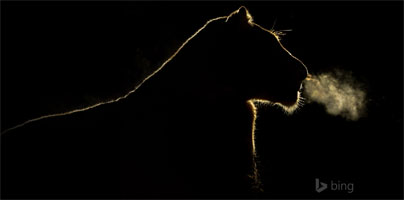The thing that sets Bing apart from other search engines is that it posts an interesting, high-quality image on its homepage, each day of the week. On the Bing Homepage Gallery, you can see what images where posted throughout the years and you can set whatever image you like as your desktop wallpaper.
I went through the images that were published this year on Bing's Homepage Gallery and I selected 33 awesome animal wallpapers. Check them out below.
1. Sleepy walrus kicks off 2015
This sleepy walrus showed up on the Bing homepage on January 1st, 2015. Posted as a “welcome to 2015”, it certainly looks like most of us felt on that day.
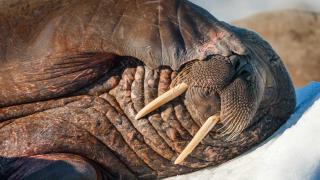
Original title – Walrus on Frozen Strait, Hudson Bay, Nunavut, Canada
© Paul Souders/Corbis
Published on January 1, 2015.
2. European otter doesn't mind the cold
It’s cold in the winter months, but that doesn’t affect the European otter. It has an incredibly dense pelt and dense underfur that protects it from the winter cold. While other animals hibernate during the winter months, this skilled swimmer remains active and hunts freshwater fish.
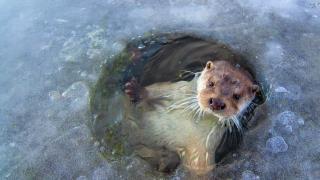
Original title – European otter near Lelystad, Netherlands
© Ernst Dirksen/Minden Pictures
Published on January 10, 2015.
3. Japanese tree frogs in the rain
The Japanese tree frogs can be found in the broadleaf forests, meadows, and swamps of Japan, Korea, China, and even parts of Mongolia and Russia. We all know that male frogs “sing” to draw females. The interesting thing is that when the male Japanese tree frogs croak, they do so without overlapping each other.
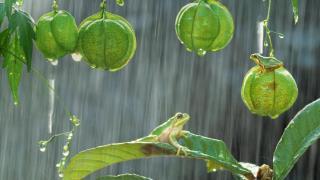
Original title – Japanese tree frogs
© Shinji Kusano/Minden Pictures
Published on January 15, 2015.
4. Fluffy penguin chicks
These Emperor penguin chicks haven’t molted their fluffy chick down yet, and that makes them look incredibly cute. The adult Emperor can reach nearly 4 feet in height and 80 pounds or more in weight.
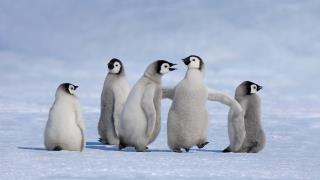
Original title – Emperor penguin chicks in Antarctica
© Jan Vermeer/Minden Pictures
Published on January 20, 2015.
5. One red squirrel goes up, another goes down
The Eurasian red squirrel changes its fur color depending on season. The winter fur is a different color than you see in the image; not only that, the winter fur is a lot thicker, something that comes in handy because the Eurasian red squirrel doesn’t fully hibernate and goes out in the cold to search for food.
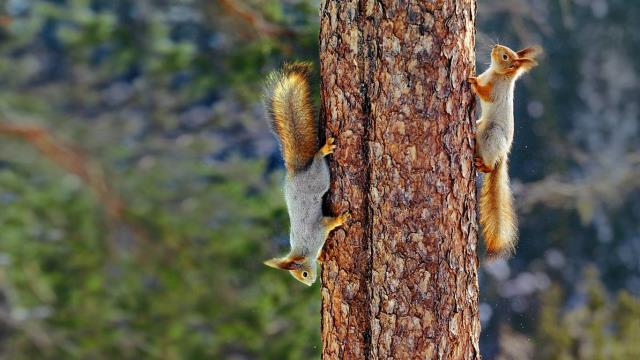
Original title – Eurasian red squirrels in Finland
© Jorma Luhta/Minden Pictures
Published on January 21, 2015.
6. Alpine marmot on Groundhog Day
To celebrate Groundhog Day, Bing published this photo of an Alpine marmot on its homepage. The Alpine marmot can be found in the grassy meadows and rocky slopes of the Alps, but there are also populations in the Carpathians, Pyrenees, and Tatras mountain ranges.
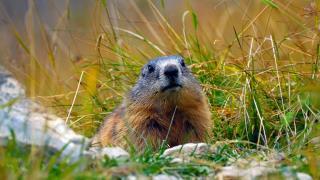
Original title – Alpine marmot
© Michael Dietrich/Alamy
Published on February 2, 2015.
7. Muskox adults with a muskox baby
Muskox start small and grow to impressive dimensions. The males are best known for the strong odor they emit during the rut; during the mating season they emit a strong musky odor that is meant to attract females. Muskox are native to the Canadian Arctic and Greenland and they’ve been introduced in parts of Norway, Siberia, and Sweden.
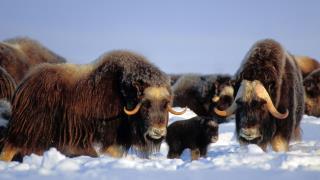
Original title – Muskox in the Brooks Range, Alaska
© Steven Kazlowski/Corbis
Published on February 7, 2015.
8. Northern pigmy owl in the snow
The northern pigmy owl, unlike many species of owls, hunts during the day and usually hunts for birds that are smaller than itself. And if you’re curious, then you need to know that the northern pigmy owl is 6-inch-long.
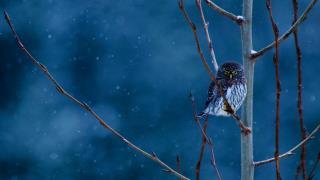
Original title – Northern pygmy-owl, Glacier National Park, Montana
© Steven Gnam/Tandem Stills + Motion
Published on February 9, 2015.
9. Rocky Mountain sheep for the Chinese New Year
To celebrate the Chinese New Year and to mark the fact that this is the Year of the Ram, Bing published a photo of a Rocky Mountain bighorn sheep on its homepage.
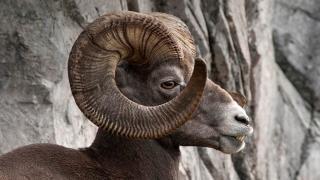
Original title – Rocky Mountain bighorn sheep in Kananaskis Country, Alberta, Canada
© Walter Nussbaumer/Corbis
Published on February 19, 2015.
10. Big eared viscacha
The southern viscacha needs those big ears to avoid predators. You see, it lives in the Andes, where it gets pretty cold at night. Their dense fur keeps them warms, but to warm themselves even more, they perch in the midday sun. As they soak in the sun, they listen for signs of trouble with their big ears.
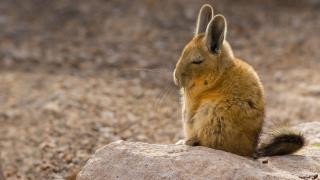
Original title – A southern viscacha in the Andes Mountains
© Chris Mattison/Minden Pictures
Published on February 22, 2015.
11. Sleeping polar bear
Bing celebrated International Polar Bear Day by posting this image of a sleeping polar bear. Since the polar bears that live in the Arctic National Wildlife Refuge (ANWR) are the top predator, they can take a nap anywhere they want. Established in 1960 and spanning more than 19 million acres, the ANWR is home to roughly 250 species of mammals, birds, and fish.
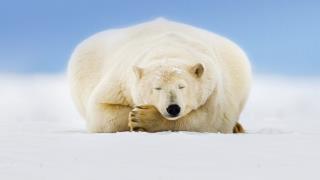
Original title – Polar bear on a barrier island in the Beaufort Sea, Arctic National Wildlife Refuge, Alaska
© Patrick Endres/plainpicture
Published on February 27, 2015.
12. The common octopus is smarter than you think
Do you know that the common octopus, which can be found along the eastern and western coasts of the Atlantic Ocean and throughout the Mediterranean Sea, is quite smart? It can recognize shapes and colors, it can solve simple puzzles, and some can even open jars.
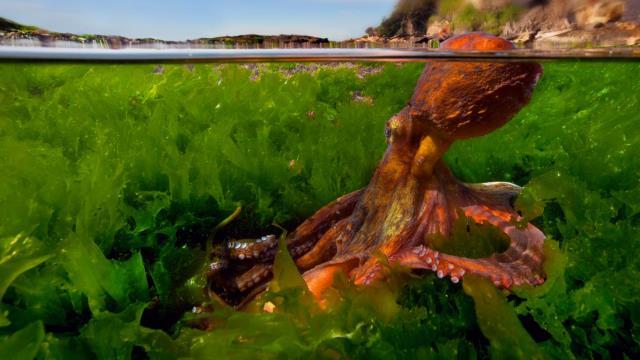
Original title – Common octopus in the Mediterranean Sea
© Pasquale Vassallo/Visuals Unlimited, Inc.
Published on March 7, 2015.
13. Frolicking lambs for the equinox
To celebrate the equinox, the time of year when daytime and nighttime are the same duration, Bing featured this photo of frolicking lambs on its homepage.
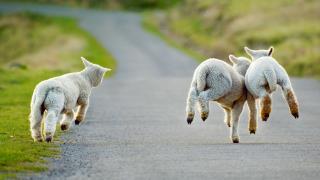
Original title – Lambs frolicking in Christchurch, New Zealand
© Andrew Walmsley/Alamy
Published on March 20, 2015.
14. West Indian manatees for Manatee Appreciation Day
On Manatee Appreciation Day, Bing published this image of West Indian manatees in the Crystal River, Florida. This is the most important habitat for manatees in the US, where as many as 350 manatees can be found in wintertime.
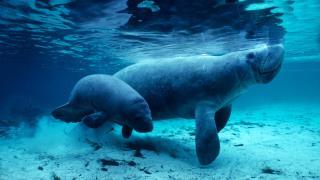
Original title – West Indian manatees in the Crystal River, Florida
© Daniel J. Cox/Corbis
Published on March 25, 2015.
15. Play-fighting fox mom and kit
The fox kit is all wet and upside-down in the water. But it seems to have a great time play-fighting with mom. Play-fighting is important for young foxes; it teaches them important hunting skills they’ll need if they’re to survive on their own.
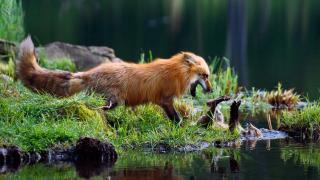
Original title – Red fox mother play-fighting with kit
© Konrad Wothe/Minden Pictures
Published on April 4, 2015.
16. American beaver on International Beaver Day
What sort of photo do you think Bing published on International Beaver Day? Why a photo of a North American beaver of course.
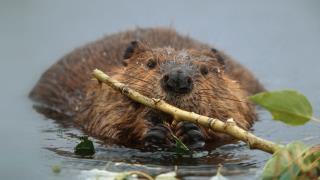
Original title – North American beaver in Denali National Park and Preserve, Alaska
© Yva Momatiuk & John Eastcott/Corbis
Published on April 7, 2015.
17. These frogs can glide through the air
Most frogs use the webbing between their toes for swimming. These use the webbing to glide through the air, from tree to tree. They’re known as black-webbed tree frogs, green flying frogs, or Reinwardt's tree frogs.
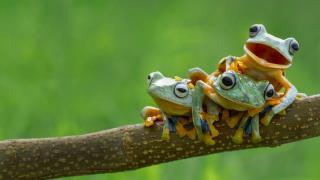
Original title – Black-webbed tree frogs
© Hendy MP/Solent News/REX
Published on April 10, 2015.
18. The blue monkey that isn’t really blue
Even though it’s called “blue monkey,” this monkey isn’t really blue. In daylight, it’s fur looks olive, not blue. It lives in the tallest reaches of the canopy, in forests situated in central and eastern Africa.
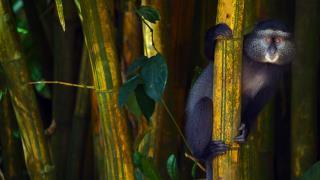
Original title – Blue monkey in the Kakamega Forest Reserve, Kenya
© Anup Shah/Minden Pictures
Published on April 15, 2015.
19. Rhino mother and calf
The one in the foreground, with the larger horn, is the mother southern white rhino. The one in the background, with the smaller horn, is the calf southern white rhino. Their horn is what attracts poachers. You see, the horn is used in Asia medicine to treat a variety of health issues. Poachers hunt rhinos to get the horns and sell them.
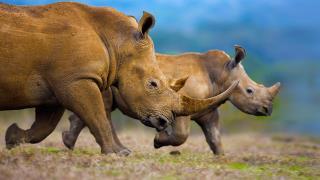
Original title – Southern white rhinoceros mother and calf
© Theo Allofs/Masterfile
Published on April 25, 2015
20. The North American porcupine is not to be petted
You may think it’s cute and you may want to pet it. But don’t! The North American porcupine is covered in quills. That’s why cougars, wolves, bears, and other predators will not attack them. They’d rather find something easier to hunt than get stung with those quills.
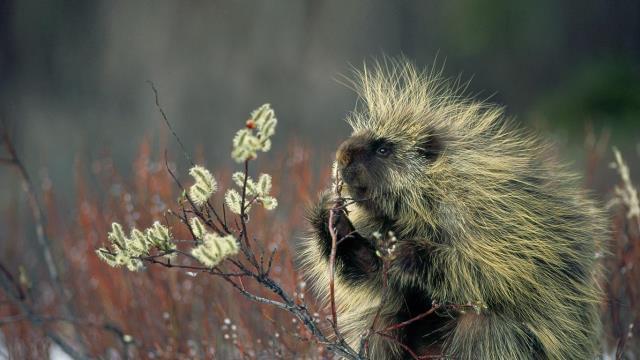
Original title – North American porcupine
© Minden Pictures/SuperStock
Published on April 30, 2015.
21. Wolf pup and mom on Mother’s Day
To celebrate Mother’s Day, Bing published this incredibly adorable photo of a wolf pup and mom.
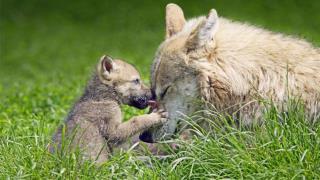
Original title – Mother wolf and pup
© Ronald Wittek/age fotostock
Published on May 10, 2015.
22. Black-tailed prairie dogs sharing some food
Black-tailed prairie dogs are social animals that live in large groups, and build warrens, burrows, and tunnels. Do you know that the warrens, burrows, and tunnels built by an extended group of black-tailed prairie dogs is called a “town”?
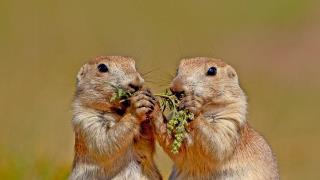
Original title – Black-tailed prairie dogs in Wind Cave National Park, South Dakota
© James Hager/age fotostock
Published on May 15, 2015.
23. Horned grebe with its chick
During the winter months, horned grebes are mostly gray and white. In spring, when they have to attract a mate, they grow colorful plumes, as you can see in the image below. They’re called horned grebe because of the flaxen tufts of feathers along the side of their heads that look like horns.
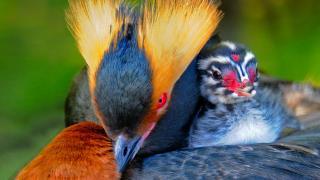
Original title – Horned grebe carrying its chick
© Winfried Wisniewski/Minden Pictures
Published on May 26, 2015.
24. Barn owl caught in slow motion
When it flies, the barn owl flies silently, so its pray cannot hear it. It’s pale appearance makes it look ghostly and its eerie shrieks may frighten some. As a matter of fact, the barn owl is considered a sinister omen and a harbinger of death in some cultures.
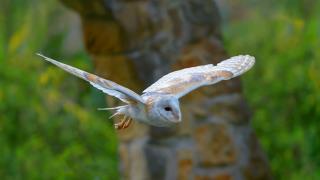
Original title – Barn owl
© Christoph Bosch/Alamy
Published on June 9, 2015.
25. Dad giraffe and his two calves on Father’s Day
June 21st was Father’s Day and World Giraffe Day. To celebrate the two, Bing published an image of a dad giraffe with its two calves.
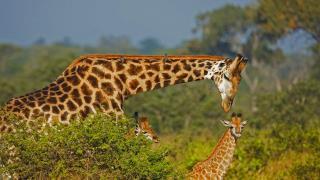
26. Lioness at night
During the day, lions prefer to sleep, stay cool and conserve energy. In the evening, when the sun sets and it cools down, that’s when the lions become active. They prefer to hunt at twilight or dawn.
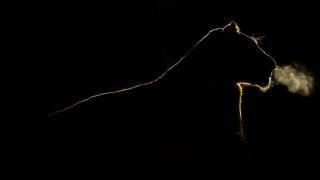
Original title – A lioness at night in the Sabi Sand Game Reserve, South Africa
© Brendon Cremer/Minden Pictures
Published on July 8, 2015
27. Giant panda in a tree
The 2-tonned giant panda, which is biologically geared to be a meat eater, sustains itself by eating bamboo. Because the panda’s digestive system isn’t very well suited to extract nutrients from bamboo, the giant panda is not an energetic, active animal.
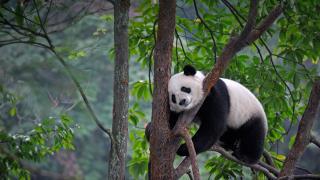
Original title – Giant panda at Bifengxia Panda Base in Ya’an, China
© Eric Baccega/Minden Pictures
Published on July 29, 2015.
28. An interesting pair
The young donkey is called Siesta. The dog is called Sudo. They both star in the photo that Bing published on International Friendship Day.
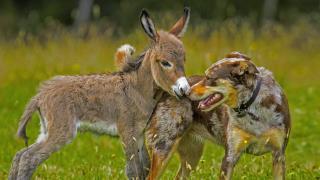
Original title – Siesta the donkey greets Sudo the dog in Melbourne, Australia
© Sarah Matray/REX Shutterstock
Published on August 2, 2015
29. Grim reminder on World Elephant Day
Bing published this cute image on World Elephant Day and reminded us that unless drastic changes are implemented, we face a near future without elephants.
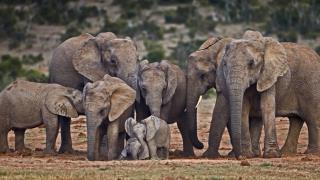
Original title – African elephants
© James Hager/Offset
Published on August 12, 2015.
30. American white pelican in flight
At nearly 6 feet long from beak to tail, the American white pelican is perhaps the longest and heaviest bird in North America.
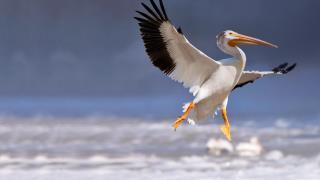
Original title – American white pelican in flight, Red River, Lockport, Manitoba, Canada
© Ken Gillespie/Corbis
Published on August 16, 2015.
31. Sea lion mother and pup
Female Galápagos sea lions give birth to a single pup. They spend the next 3 years taking care of that pup, until it’s ready to face the world on its own.
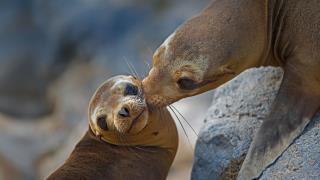
Original title – Galápagos sea lion mother and pup on Floreana Island, Ecuador
© Tui De Roy/Minden Pictures
Published on September 3, 2015.
32. Leafcutter ants on Labor Day
Since ants are known for being hard workers, Bing published a photo of leafcutter ants on Labor Day. Native to Central and South America, the leafcutter ants chop up plants, take them to the colony, and use them to grow fungus. The ants don’t eat the plant matter, they eat the fungus that they grow from the plants.
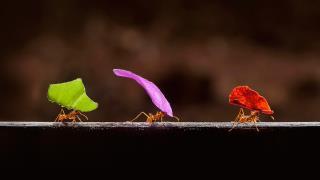
Original title – Leafcutter ants in Boca Tapada, Costa Rica
© Bence Mate/Visuals Unlimited/Corbis
Published on September 7, 2015.
33. Small woodland bird known as the coal tit
The small woodland bird in this image is known as the coal tit. It can be spotted throughout Europe, Asia, and even north Africa. They eat pine nuts in pine forests; but if you put up a bird feeder with sunflower seeds, the coal tit will be happy to visit it.
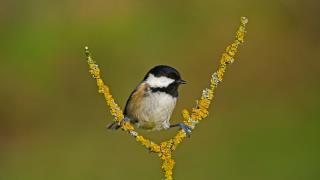
Original title – A coal tit taking a break
© NHPA/SuperStock
Published on September 9, 2015.
Change your wallpaper by using Bing Desktop
Microsoft’s Bing Desktop is meant to help you easily access the Bing search engine. But I don’t want to focus on that. What I want to point out its that Bing Desktop can change your desktop wallpaper.
It can automatically change your wallpaper to match the image on Bing.com. On top of that, it lets you see what images were published on Bing in the past; you can set whichever image catches your eye as your desktop wallpaper.
Bing Desktop for Windows is available for download right here on FindMySoft.
I went through the images that were published this year on Bing's Homepage Gallery and I selected 33 awesome animal wallpapers. Check them out below.
1. Sleepy walrus kicks off 2015
This sleepy walrus showed up on the Bing homepage on January 1st, 2015. Posted as a “welcome to 2015”, it certainly looks like most of us felt on that day.

Original title – Walrus on Frozen Strait, Hudson Bay, Nunavut, Canada
© Paul Souders/Corbis
Published on January 1, 2015.
2. European otter doesn't mind the cold
It’s cold in the winter months, but that doesn’t affect the European otter. It has an incredibly dense pelt and dense underfur that protects it from the winter cold. While other animals hibernate during the winter months, this skilled swimmer remains active and hunts freshwater fish.

Original title – European otter near Lelystad, Netherlands
© Ernst Dirksen/Minden Pictures
Published on January 10, 2015.
3. Japanese tree frogs in the rain
The Japanese tree frogs can be found in the broadleaf forests, meadows, and swamps of Japan, Korea, China, and even parts of Mongolia and Russia. We all know that male frogs “sing” to draw females. The interesting thing is that when the male Japanese tree frogs croak, they do so without overlapping each other.

Original title – Japanese tree frogs
© Shinji Kusano/Minden Pictures
Published on January 15, 2015.
4. Fluffy penguin chicks
These Emperor penguin chicks haven’t molted their fluffy chick down yet, and that makes them look incredibly cute. The adult Emperor can reach nearly 4 feet in height and 80 pounds or more in weight.

Original title – Emperor penguin chicks in Antarctica
© Jan Vermeer/Minden Pictures
Published on January 20, 2015.
5. One red squirrel goes up, another goes down
The Eurasian red squirrel changes its fur color depending on season. The winter fur is a different color than you see in the image; not only that, the winter fur is a lot thicker, something that comes in handy because the Eurasian red squirrel doesn’t fully hibernate and goes out in the cold to search for food.

Original title – Eurasian red squirrels in Finland
© Jorma Luhta/Minden Pictures
Published on January 21, 2015.
6. Alpine marmot on Groundhog Day
To celebrate Groundhog Day, Bing published this photo of an Alpine marmot on its homepage. The Alpine marmot can be found in the grassy meadows and rocky slopes of the Alps, but there are also populations in the Carpathians, Pyrenees, and Tatras mountain ranges.

Original title – Alpine marmot
© Michael Dietrich/Alamy
Published on February 2, 2015.
7. Muskox adults with a muskox baby
Muskox start small and grow to impressive dimensions. The males are best known for the strong odor they emit during the rut; during the mating season they emit a strong musky odor that is meant to attract females. Muskox are native to the Canadian Arctic and Greenland and they’ve been introduced in parts of Norway, Siberia, and Sweden.

Original title – Muskox in the Brooks Range, Alaska
© Steven Kazlowski/Corbis
Published on February 7, 2015.
8. Northern pigmy owl in the snow
The northern pigmy owl, unlike many species of owls, hunts during the day and usually hunts for birds that are smaller than itself. And if you’re curious, then you need to know that the northern pigmy owl is 6-inch-long.

Original title – Northern pygmy-owl, Glacier National Park, Montana
© Steven Gnam/Tandem Stills + Motion
Published on February 9, 2015.
9. Rocky Mountain sheep for the Chinese New Year
To celebrate the Chinese New Year and to mark the fact that this is the Year of the Ram, Bing published a photo of a Rocky Mountain bighorn sheep on its homepage.

Original title – Rocky Mountain bighorn sheep in Kananaskis Country, Alberta, Canada
© Walter Nussbaumer/Corbis
Published on February 19, 2015.
10. Big eared viscacha
The southern viscacha needs those big ears to avoid predators. You see, it lives in the Andes, where it gets pretty cold at night. Their dense fur keeps them warms, but to warm themselves even more, they perch in the midday sun. As they soak in the sun, they listen for signs of trouble with their big ears.

Original title – A southern viscacha in the Andes Mountains
© Chris Mattison/Minden Pictures
Published on February 22, 2015.
11. Sleeping polar bear
Bing celebrated International Polar Bear Day by posting this image of a sleeping polar bear. Since the polar bears that live in the Arctic National Wildlife Refuge (ANWR) are the top predator, they can take a nap anywhere they want. Established in 1960 and spanning more than 19 million acres, the ANWR is home to roughly 250 species of mammals, birds, and fish.

Original title – Polar bear on a barrier island in the Beaufort Sea, Arctic National Wildlife Refuge, Alaska
© Patrick Endres/plainpicture
Published on February 27, 2015.
12. The common octopus is smarter than you think
Do you know that the common octopus, which can be found along the eastern and western coasts of the Atlantic Ocean and throughout the Mediterranean Sea, is quite smart? It can recognize shapes and colors, it can solve simple puzzles, and some can even open jars.

Original title – Common octopus in the Mediterranean Sea
© Pasquale Vassallo/Visuals Unlimited, Inc.
Published on March 7, 2015.
13. Frolicking lambs for the equinox
To celebrate the equinox, the time of year when daytime and nighttime are the same duration, Bing featured this photo of frolicking lambs on its homepage.

Original title – Lambs frolicking in Christchurch, New Zealand
© Andrew Walmsley/Alamy
Published on March 20, 2015.
14. West Indian manatees for Manatee Appreciation Day
On Manatee Appreciation Day, Bing published this image of West Indian manatees in the Crystal River, Florida. This is the most important habitat for manatees in the US, where as many as 350 manatees can be found in wintertime.

Original title – West Indian manatees in the Crystal River, Florida
© Daniel J. Cox/Corbis
Published on March 25, 2015.
15. Play-fighting fox mom and kit
The fox kit is all wet and upside-down in the water. But it seems to have a great time play-fighting with mom. Play-fighting is important for young foxes; it teaches them important hunting skills they’ll need if they’re to survive on their own.

Original title – Red fox mother play-fighting with kit
© Konrad Wothe/Minden Pictures
Published on April 4, 2015.
16. American beaver on International Beaver Day
What sort of photo do you think Bing published on International Beaver Day? Why a photo of a North American beaver of course.

Original title – North American beaver in Denali National Park and Preserve, Alaska
© Yva Momatiuk & John Eastcott/Corbis
Published on April 7, 2015.
17. These frogs can glide through the air
Most frogs use the webbing between their toes for swimming. These use the webbing to glide through the air, from tree to tree. They’re known as black-webbed tree frogs, green flying frogs, or Reinwardt's tree frogs.

Original title – Black-webbed tree frogs
© Hendy MP/Solent News/REX
Published on April 10, 2015.
18. The blue monkey that isn’t really blue
Even though it’s called “blue monkey,” this monkey isn’t really blue. In daylight, it’s fur looks olive, not blue. It lives in the tallest reaches of the canopy, in forests situated in central and eastern Africa.

Original title – Blue monkey in the Kakamega Forest Reserve, Kenya
© Anup Shah/Minden Pictures
Published on April 15, 2015.
19. Rhino mother and calf
The one in the foreground, with the larger horn, is the mother southern white rhino. The one in the background, with the smaller horn, is the calf southern white rhino. Their horn is what attracts poachers. You see, the horn is used in Asia medicine to treat a variety of health issues. Poachers hunt rhinos to get the horns and sell them.

Original title – Southern white rhinoceros mother and calf
© Theo Allofs/Masterfile
Published on April 25, 2015
20. The North American porcupine is not to be petted
You may think it’s cute and you may want to pet it. But don’t! The North American porcupine is covered in quills. That’s why cougars, wolves, bears, and other predators will not attack them. They’d rather find something easier to hunt than get stung with those quills.

Original title – North American porcupine
© Minden Pictures/SuperStock
Published on April 30, 2015.
21. Wolf pup and mom on Mother’s Day
To celebrate Mother’s Day, Bing published this incredibly adorable photo of a wolf pup and mom.

Original title – Mother wolf and pup
© Ronald Wittek/age fotostock
Published on May 10, 2015.
22. Black-tailed prairie dogs sharing some food
Black-tailed prairie dogs are social animals that live in large groups, and build warrens, burrows, and tunnels. Do you know that the warrens, burrows, and tunnels built by an extended group of black-tailed prairie dogs is called a “town”?

Original title – Black-tailed prairie dogs in Wind Cave National Park, South Dakota
© James Hager/age fotostock
Published on May 15, 2015.
23. Horned grebe with its chick
During the winter months, horned grebes are mostly gray and white. In spring, when they have to attract a mate, they grow colorful plumes, as you can see in the image below. They’re called horned grebe because of the flaxen tufts of feathers along the side of their heads that look like horns.

Original title – Horned grebe carrying its chick
© Winfried Wisniewski/Minden Pictures
Published on May 26, 2015.
24. Barn owl caught in slow motion
When it flies, the barn owl flies silently, so its pray cannot hear it. It’s pale appearance makes it look ghostly and its eerie shrieks may frighten some. As a matter of fact, the barn owl is considered a sinister omen and a harbinger of death in some cultures.

Original title – Barn owl
© Christoph Bosch/Alamy
Published on June 9, 2015.
25. Dad giraffe and his two calves on Father’s Day
June 21st was Father’s Day and World Giraffe Day. To celebrate the two, Bing published an image of a dad giraffe with its two calves.

26. Lioness at night
During the day, lions prefer to sleep, stay cool and conserve energy. In the evening, when the sun sets and it cools down, that’s when the lions become active. They prefer to hunt at twilight or dawn.

Original title – A lioness at night in the Sabi Sand Game Reserve, South Africa
© Brendon Cremer/Minden Pictures
Published on July 8, 2015
27. Giant panda in a tree
The 2-tonned giant panda, which is biologically geared to be a meat eater, sustains itself by eating bamboo. Because the panda’s digestive system isn’t very well suited to extract nutrients from bamboo, the giant panda is not an energetic, active animal.

Original title – Giant panda at Bifengxia Panda Base in Ya’an, China
© Eric Baccega/Minden Pictures
Published on July 29, 2015.
28. An interesting pair
The young donkey is called Siesta. The dog is called Sudo. They both star in the photo that Bing published on International Friendship Day.

Original title – Siesta the donkey greets Sudo the dog in Melbourne, Australia
© Sarah Matray/REX Shutterstock
Published on August 2, 2015
29. Grim reminder on World Elephant Day
Bing published this cute image on World Elephant Day and reminded us that unless drastic changes are implemented, we face a near future without elephants.

Original title – African elephants
© James Hager/Offset
Published on August 12, 2015.
30. American white pelican in flight
At nearly 6 feet long from beak to tail, the American white pelican is perhaps the longest and heaviest bird in North America.

Original title – American white pelican in flight, Red River, Lockport, Manitoba, Canada
© Ken Gillespie/Corbis
Published on August 16, 2015.
31. Sea lion mother and pup
Female Galápagos sea lions give birth to a single pup. They spend the next 3 years taking care of that pup, until it’s ready to face the world on its own.

Original title – Galápagos sea lion mother and pup on Floreana Island, Ecuador
© Tui De Roy/Minden Pictures
Published on September 3, 2015.
32. Leafcutter ants on Labor Day
Since ants are known for being hard workers, Bing published a photo of leafcutter ants on Labor Day. Native to Central and South America, the leafcutter ants chop up plants, take them to the colony, and use them to grow fungus. The ants don’t eat the plant matter, they eat the fungus that they grow from the plants.

Original title – Leafcutter ants in Boca Tapada, Costa Rica
© Bence Mate/Visuals Unlimited/Corbis
Published on September 7, 2015.
33. Small woodland bird known as the coal tit
The small woodland bird in this image is known as the coal tit. It can be spotted throughout Europe, Asia, and even north Africa. They eat pine nuts in pine forests; but if you put up a bird feeder with sunflower seeds, the coal tit will be happy to visit it.

Original title – A coal tit taking a break
© NHPA/SuperStock
Published on September 9, 2015.
Change your wallpaper by using Bing Desktop
Microsoft’s Bing Desktop is meant to help you easily access the Bing search engine. But I don’t want to focus on that. What I want to point out its that Bing Desktop can change your desktop wallpaper.
It can automatically change your wallpaper to match the image on Bing.com. On top of that, it lets you see what images were published on Bing in the past; you can set whichever image catches your eye as your desktop wallpaper.
Bing Desktop for Windows is available for download right here on FindMySoft.

